A look inside G.S. Gelato's plant
The Italian-born owners of G.S. Gelato bring their recipes and production equipment to Florida’s Panhandle where they make authentic Italian gelato for retail and foodservice customers.

Gelato flows from the freezer into a pan at G.S. Gelato’s facility in Fort Walton Beach, Fla. The processor also makes sorbets and frozen yogurt.

To make authentic gelato, you need authentic equipment, say the owners of G.S. Gelato, based in Florida. They imported vats, pasteurizers and freezers from Italy. Ingredients come from around the world.

Pints bound for retailers are filled on a rotary filler. Later, they receive a tamper-evident seal around the lid.

At G.S. Gelato, pints and pans filled with gelato pass through a metal detector.






The headquarters and manufacturing plant of G.S. Gelato, Fort Walton Beach, Fla., are far from the scenic Gulf Coast views in this resort town on the Emerald Coast of Florida’s panhandle. To find the place, one turns off the main road and drives a half-mile through an industrial zone dotted with pine trees. The casual observer would never know that world-class gelato and sorbet are being made in this nondescript building located next to a scrap metal recycler.
Owner Guido Tremolini chose the location and the building for its durable concrete-block construction. He had seen the devastation a hurricane can wreak when he and his wife Simona Faroni first came to Florida from Italy in the mid-1990s.
Tremolini and Faroni are the founders and owners of G.S. Gelato. In less than 20 years, they have created a business that sells branded and private-label gelato, sorbet and frozen yogurt up and down the East Coast and across the nation. (See related article on page 34.)
The owners and their two rescue dogs greet visitors to the headquarters. Tremolini offers to make espresso in his 50-year-old Faema espresso machine while he tells the story of coming to America. On vacation in Florida, they could not find gelato. They made it their mission then to move to the United States, open a scoop shop and manufacture authentic Italian-style gelato for wholesale. The plan was to process the gelato in Italian-made equipment.
Almost immediately, they ran into licensing requirements and regulatory roadblocks. Serving gelato from a storefront required a permit from Florida’s Department of Business. Wholesaling of dairy products, on the other hand, falls under the purview of the state’s Department of Agriculture & Consumer Services, and specifically the Bureau of the Dairy Industry.
Gary Newton, an environmental administrator in the bureau, recalled the early meetings with the owners. He discovered that the European-made equipment was “designed to make product but not for sanitation.” He explained that the agitator wells were not sealed, which allowed product to leak into areas that could not be reached to be cleaned. The equipment had to be redesigned to meet Florida regulations.
It took Tremolini and Faroni 14 months to bring everything up to code. The owners were frustrated by the delays, but were impressed that the state helped them with compliance rather than turning them down outright and leaving it like that. In Italy, government agencies aren’t cooperative, Faroni said. They credit Newton and his bureau for helping them get started.
“They did everything we asked them to do,” Newton said.
Usually, a visitor can identify a facility as a dairy processing plant by the milk silos outside. There are no silos here. The dairy ingredients arrive in sacks (nonfat dry milk powder) and bottles (heavy cream). In the pasteurization room, employees blend powders with water, 36% heavy cream, flavors and other ingredients, which are then vat pasteurized in small batches for 30 minutes at 175F to 180F. Tremolini said pasteurization is the first step in making authentic gelato. “We do it for a quality product,” he said.
Each gelato and sorbet recipe is built without a mix or a base. All recipes for all of the flavors are carefully balanced and the entire recipe, including the flavor, is pasteurized.
G.S. Gelato has a battery of manual pasteurizers imported from Italy. The high-speed, 3,000 r.p.m. emulsifier breaks down fats and blends all the ingredients into a creamy and smooth texture, Faroni said. The fat molecules in gelato are smaller than in ice cream mix, hence the smoother mouthfeel.
After homogenization, the mixture moves through a plate cooler. Now cooled to 41F, the mix flows through pipes to the adjacent production room with seven holding tanks.
G.S. Gelato has two production systems. One is fully manual, with small pasteurizers, aging tanks and a traditional batch freezer. This system is used to fill the foodservice trays for gelateria, coffee shops, the deli/bakery department in grocery stores and other venues. This system entails pasteurization of the entire recipe (including flavor); manual transfer in 5-gallon buckets to aging vats, then into batch freezers and then into a filler.
The other, larger system is used for all products to be packaged for retail, including pints, quarts and pans. The automatic system pumps the pasteurized product to the continuous freezer and then to the automatic filling station. During Dairy Foods’visit in March, the company was installing a new 1,400-liter-per-hour (370-gallon) continuous freezer.
Depending upon the format, the gelato is pumped to a half-liter or a one-liter filler. Filled pint packages pass through a metal detector, receive a tamper-evident safety ring and then are bundled and conveyed to the frozen warehouse. Five-liter pans for retail and commercial foodservice accounts are filled on a separate line. The pans are then wrapped in plastic and stored in the freezer.
There is no federal standard of identity for gelato like there is for ice cream. The production of gelato and ice cream is similar, but not exactly the same. Gelato requires great attention to detail, especially in limiting the formation of ice crystals, Tremolini said. This is the expertise he and his production staff bring to the process.
Ice cream experts (and Dairy Foodscolumnists) Bruce Tharp and Steve Young write that limiting ice crystals in any frozen dessert is critical, and especially so with gelato. The speed of the dasher in the freezer can control the formation of ice crystals, according to their book “Tharp & Young On Ice Cream, An Encyclopedic Guide to Ice Cream Science and Technology.”
In scoop shops, the product is held at higher temperatures for consumption. Less water is frozen, meaning that more water is available to participate in the growth of ice crystals, explain Tharp and Young. Because of these and other factors they write, “gelato is vulnerable to the development of textural defects. Therefore, the control of ice crystal growth via management of water mobility is equally as important, if not more so, than would be the case for conventional ice cream compositions.”
In addition to the high-speed emulsification of ingredients, low overrun also contributes to the creaminess and premium quality of the product, Tremolini said. In their book, Tharp and Young note that the density of gelato typically ranges from no injected air (zero overrun) to 15% to 20% or more.
Tremolini said gelato overrun should never be below 30% to 35%. “Gelato can never be at zero overrun or 10% to 15%, otherwise it would be frozen pudding. In regular batch freezers, the mechanical incorporation of air allows for the product to incorporate just the right amount, which varies depending on the flavors.”
Chocolate or hazelnut gelato will naturally incorporate less air than lemon or pineapple sorbet, he said.
Making frozen yogurt
Frozen yogurt mix is produced in a separate room next to the filling area. The frozen yogurt process entails pasteurization of the entire recipe, homogenization, automatic transfer to aging vats, addition of probiotics and bottling.
There are six 350-gallon flavor vats and two 160-gallon culturing tanks. After pasteurization, the company adds the live and active probiotic cultures S. thermophilus, L. bulgaricus, L. lactic andL. acidophilus. Most flavors are gluten-free, and are made with real fruit and no high-fructose corn syrup. The company makes more than 54 flavors of liquid frozen yogurt mix and a half-dozen seasonal flavors. Plastic gallon containers are filled with mix by hand, placed four to a case and rolled on carts to the freezer.
The Florida Department of Agriculture inspects the plant quarterly and tests samples of finished product monthly. Faroni said G.S. Gelato is the only gelato company in the United States with an SQF 2000 Level 3 certification. HACCP steps are clearly posted in every area of the production facility.
G.S. Gelato tests the products every step of the way, Tremolini said. The mix is tested after pasteurization, batching, filling and prior to release. The lab performs microbial and organoleptic tests. Samples from every batch are weighed, cut, photographed and filed for reference. The company also makes random checks of products held in the freezer.
G.S. Gelato follows good manufacturing processes, but “our core value is not just manufacturing,” Faroni said. “We create, develop, partner and offer custom solutions in flavors, formulations, packaging, equipment and training.”
The company manufactures private-label gelato, sorbets and frozen yogurt for supermarket clients and for foodservice accounts. Tremolini has developed thousands of recipes, but he is happy to develop custom flavors and source the perfect ingredients for customers.
Regulatory issues delayed Tremolini and Faroni for more than a year when they emigrated from Italy. That’s history. These days, the duo is moving full-speed ahead. They are adding capacity to their plant to meet customer demand and achieving their goal of serving authentic Italian gelato to Americans.
“It’s been fun watching them grow over the years,” said Newton of the Department of Agriculture.
At-A-Glance |
|
G.S. Gelato, Fort Walton Beach, Fla. Size of plant: 26,000 square feet Number of production employees: 30 Products made: Gelato, sorbet, frozen yogurt, and frozen yogurt mix Certification: SQF 2000 Level 3 Total processing capacity: 1.3 million gallons per year Pasteurization process: Vat pasteurization Freezers: Batch and continuous freezers Fillers: ½ and 1-liter containers, 5-liter pan, 1-gallon trays, rotary machine (pints, quarts, scrounds) Warehouse: 15,000 square feet |
Looking for a reprint of this article?
From high-res PDFs to custom plaques, order your copy today!













